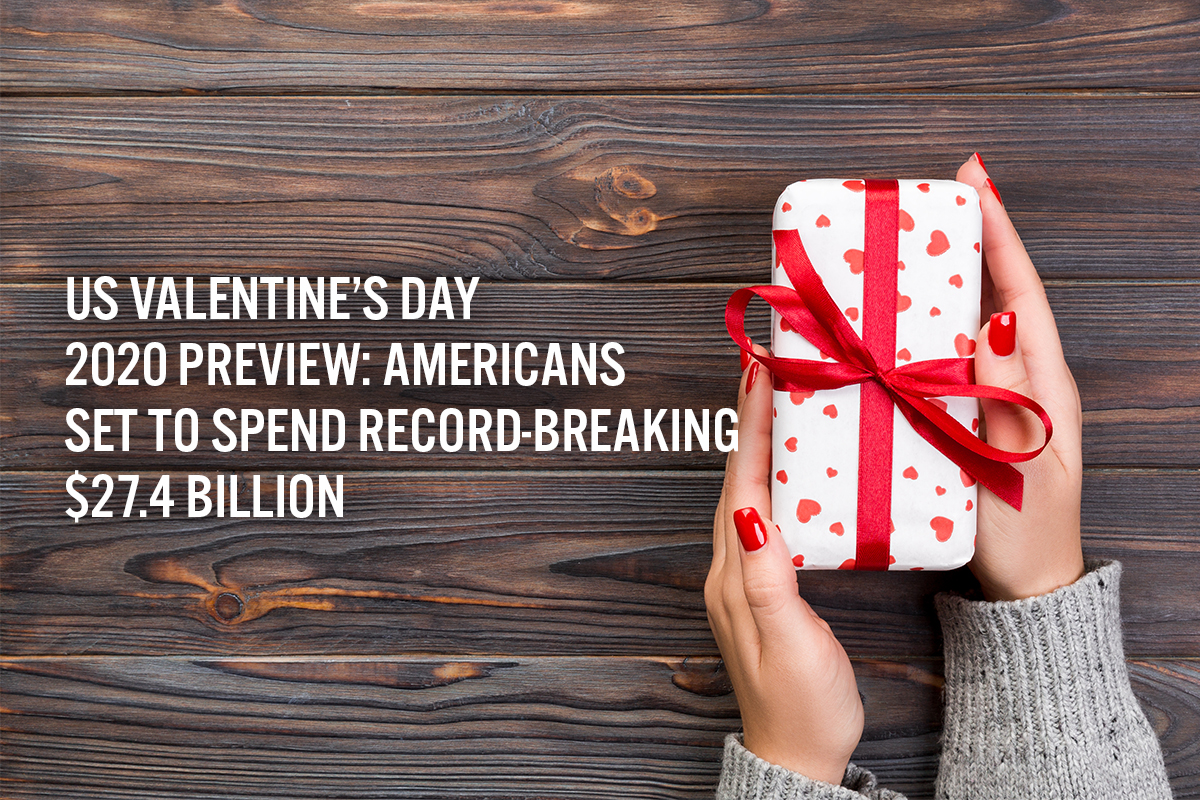
Nitheesh NH
US Valentine’s Day spending in 2020 is expected to be strong, according to an annual survey released by the NRF and Prosper Insights & Analytics. The percentage of people expecting to celebrate the day climbed to 55% in 2020, after dropping to 51% last year and in-line with the average for the past decade.
The NRF and Prosper estimate total spending will hit $27.4 billion, up 32% from $20.7 billion last year, and nearly double 2010’s $14.1 billion. Average spending per shopper is estimated to be $196.31, up fully 21% from last year’s $161.96. The NRF attributes the substantial increase in average spending to strong consumer finances and continued growth in consumers buying for non-traditional recipients (i.e. not just girlfriends and spouses), including gifts, candy, cards and flowers for family, friends, coworkers and even pets.
[caption id="attachment_103278" align="aligncenter" width="700"] Source: NRF/Prosper Insights & Analytics[/caption]
Spending Will be Driven by Consumers Aged 25–44
Among those expecting to spend for Valentine’s Day 2020, the biggest spenders will be those aged 35–44 years, who say they will spend an average of $358.78, followed by 25–34-year olds at $307.51. These age groups have higher incomes and children to buy for. The lowest average spenders among those expecting to spend for Valentine’s Day are aged 65 years and older, at just $99.14.
[caption id="attachment_103279" align="aligncenter" width="700"]
Source: NRF/Prosper Insights & Analytics[/caption]
Spending Will be Driven by Consumers Aged 25–44
Among those expecting to spend for Valentine’s Day 2020, the biggest spenders will be those aged 35–44 years, who say they will spend an average of $358.78, followed by 25–34-year olds at $307.51. These age groups have higher incomes and children to buy for. The lowest average spenders among those expecting to spend for Valentine’s Day are aged 65 years and older, at just $99.14.
[caption id="attachment_103279" align="aligncenter" width="700"]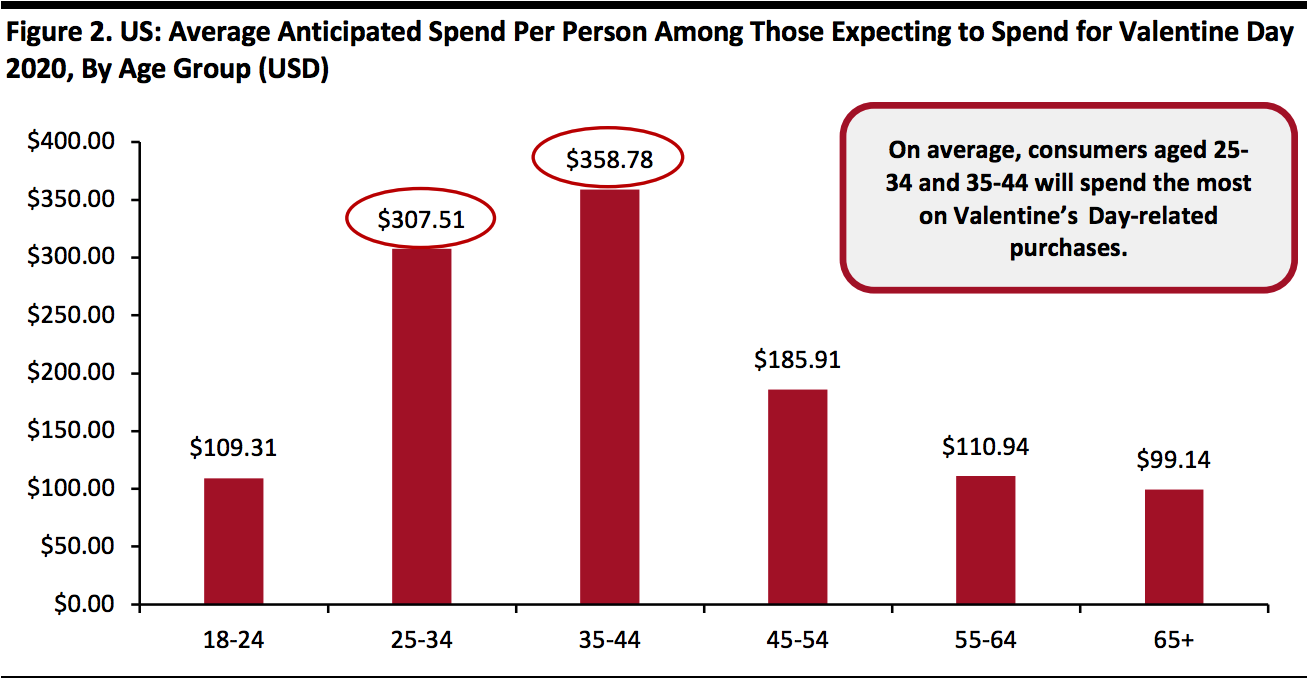 Source: NRF/Prosper Insights & Analytics[/caption]
Planned Valentine’s Day 2020 Gift Purchases
Candy remained the most popular single gift item, with 52.4% of those planning to spend on the occasion saying they will buy candy, in line with 52.2% last year. This translates to an estimated $2.4 billion spending on candy. Greeting cards came in second at 42.9% and an estimated $1.3 billion in spending, followed by flowers at 36.6% and $2.3 billion in spending. Greetings cards have been steadily declining since peaking at 55% in 2013.
In terms of estimated spend, jewelry remains the biggest Valentine’s Day gift category, with consumers planning to spend $5.8 billion on jewelry. Evening outings and clothing are the next-biggest gift categories, with expected spend of $4.3 billion and $2.9 billion, respectively.
[caption id="attachment_103280" align="aligncenter" width="700"]
Source: NRF/Prosper Insights & Analytics[/caption]
Planned Valentine’s Day 2020 Gift Purchases
Candy remained the most popular single gift item, with 52.4% of those planning to spend on the occasion saying they will buy candy, in line with 52.2% last year. This translates to an estimated $2.4 billion spending on candy. Greeting cards came in second at 42.9% and an estimated $1.3 billion in spending, followed by flowers at 36.6% and $2.3 billion in spending. Greetings cards have been steadily declining since peaking at 55% in 2013.
In terms of estimated spend, jewelry remains the biggest Valentine’s Day gift category, with consumers planning to spend $5.8 billion on jewelry. Evening outings and clothing are the next-biggest gift categories, with expected spend of $4.3 billion and $2.9 billion, respectively.
[caption id="attachment_103280" align="aligncenter" width="700"]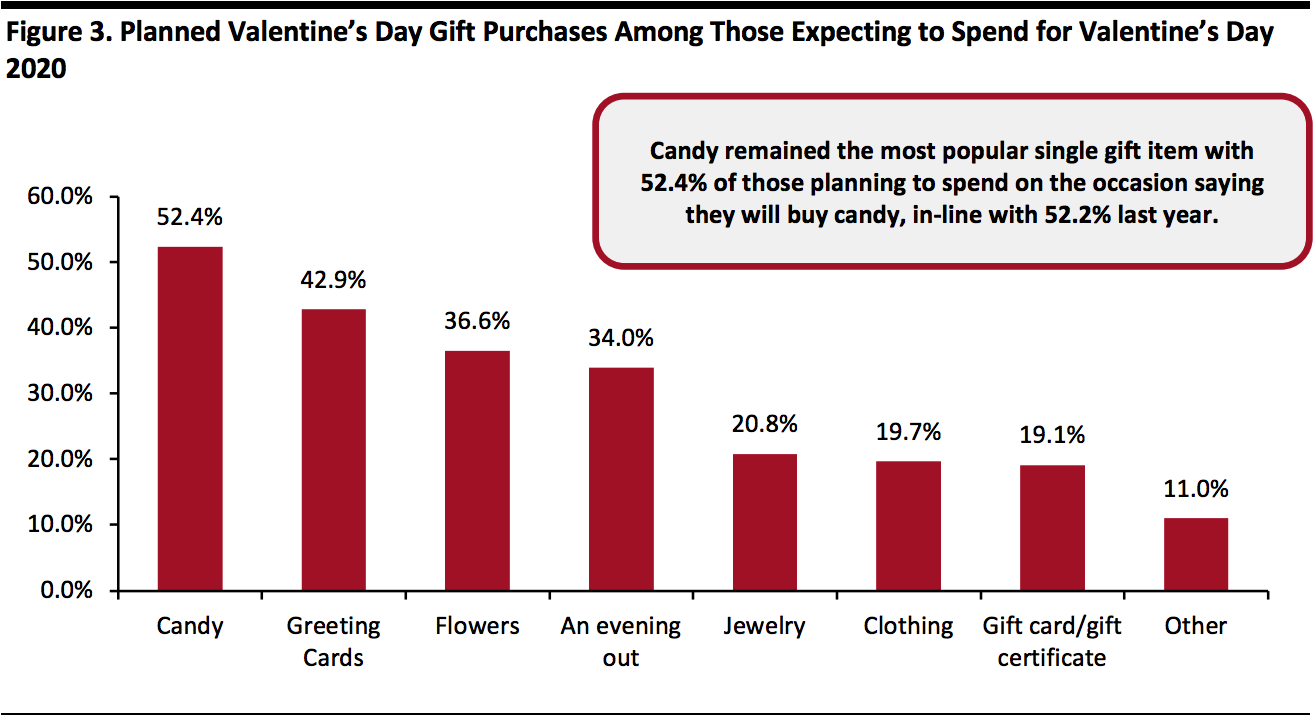 Source: NRF/Prosper Insights & Analytics[/caption]
Department Stores Remain the Most Preferred Shopping Destination
For US shoppers, department stores remain the preferred destination to buy Valentine’s Day gifts, with 36.1% of those who plan to shop saying they will buy at a department store, up slightly from 35.0% in 2019. Discount stores remained the second-most preferred shopping destination at 31.6%. In fact, shopping destination preferences remain largely unchanged from 2019, except that online has gained ground with 31.5% saying it will be their preferred destination in 2020, up from 27.4% last year.
[caption id="attachment_103281" align="aligncenter" width="700"]
Source: NRF/Prosper Insights & Analytics[/caption]
Department Stores Remain the Most Preferred Shopping Destination
For US shoppers, department stores remain the preferred destination to buy Valentine’s Day gifts, with 36.1% of those who plan to shop saying they will buy at a department store, up slightly from 35.0% in 2019. Discount stores remained the second-most preferred shopping destination at 31.6%. In fact, shopping destination preferences remain largely unchanged from 2019, except that online has gained ground with 31.5% saying it will be their preferred destination in 2020, up from 27.4% last year.
[caption id="attachment_103281" align="aligncenter" width="700"]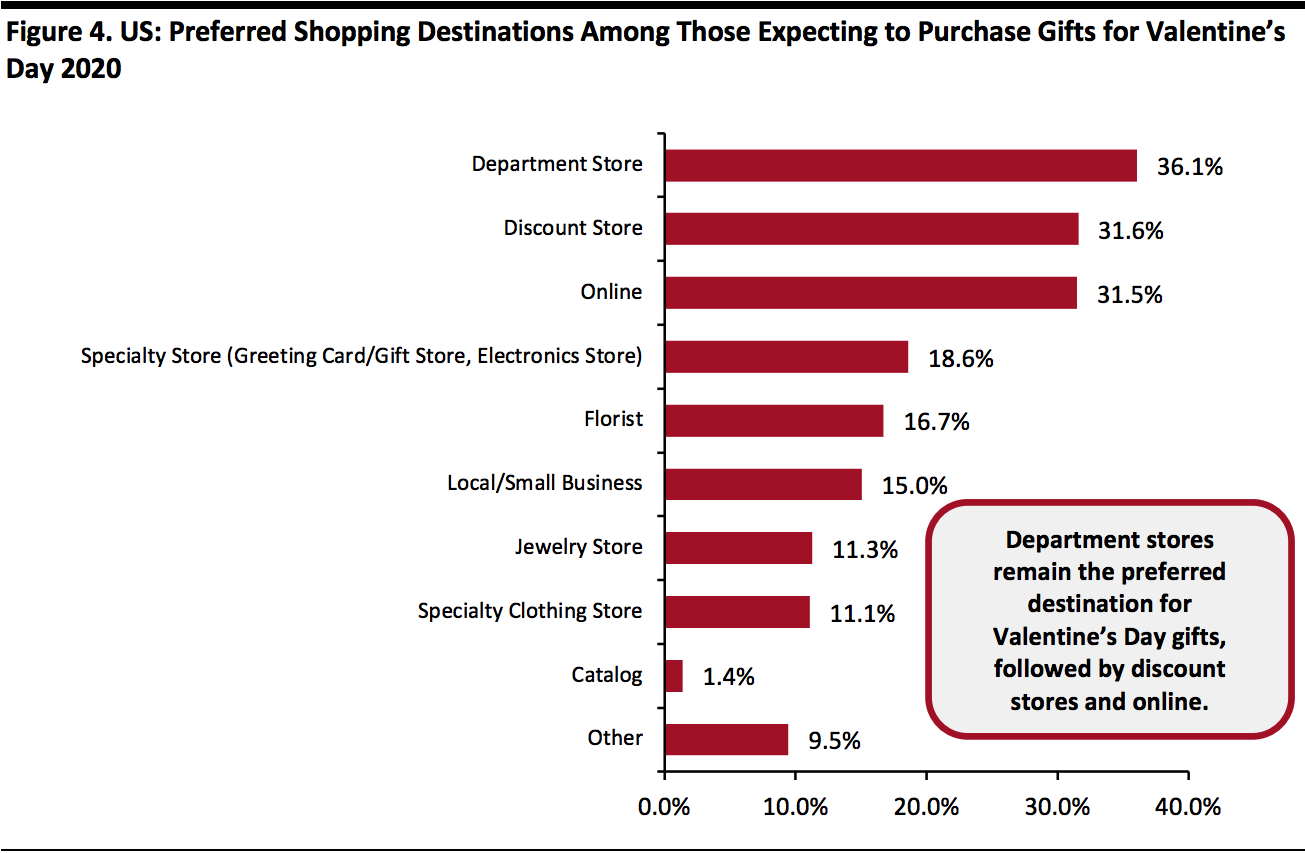 Source: NRF/Prosper Insights & Analytics[/caption]
Gifts of Experience Continue to Gain Popularity
This year, “gifts of experience,” such as a movie ticket, a hot air balloon ride or a trip to a spa, gained importance, with 28.3% of respondents saying they plan to give an experience, up from 24.8% last year. But while 28.3% said they plan to give a gift of an experience, 41.0% said they would like to receive one, compared to 40% last year.
Majority of Valentine’s Celebrants Own Smartphones
Among those who wish to celebrate Valentine’s Day, about 91% own a smartphone, of whom nearly 45% plan to research products and compare prices before buying, 34% expect to buy something and 25% plan to look up retailer information, such as location and store hours.
[caption id="attachment_103282" align="aligncenter" width="700"]
Source: NRF/Prosper Insights & Analytics[/caption]
Gifts of Experience Continue to Gain Popularity
This year, “gifts of experience,” such as a movie ticket, a hot air balloon ride or a trip to a spa, gained importance, with 28.3% of respondents saying they plan to give an experience, up from 24.8% last year. But while 28.3% said they plan to give a gift of an experience, 41.0% said they would like to receive one, compared to 40% last year.
Majority of Valentine’s Celebrants Own Smartphones
Among those who wish to celebrate Valentine’s Day, about 91% own a smartphone, of whom nearly 45% plan to research products and compare prices before buying, 34% expect to buy something and 25% plan to look up retailer information, such as location and store hours.
[caption id="attachment_103282" align="aligncenter" width="700"]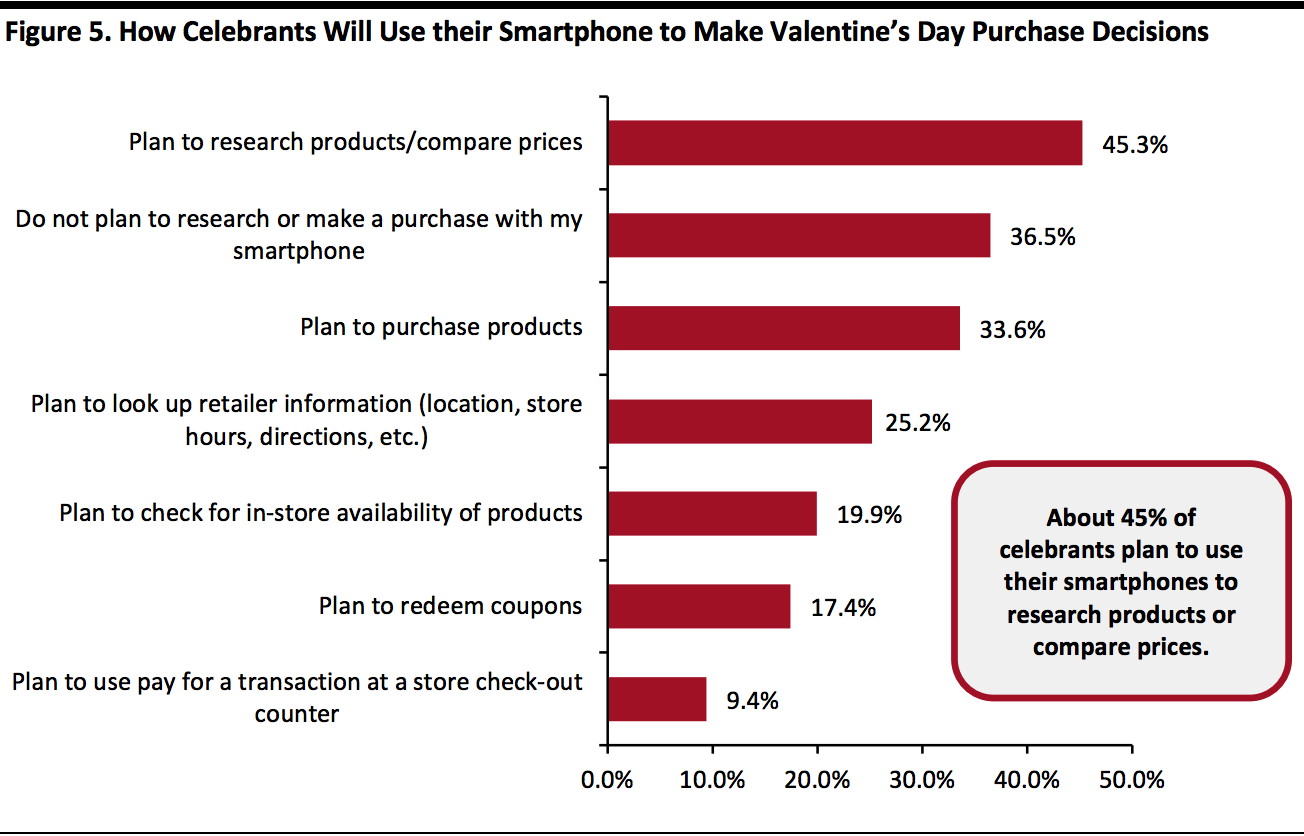 Source: NRF/Prosper Insights & Analytics[/caption]
Key Insights
Valentine’s Day spending in the US is estimated to hit a record $27.4 billion in 2020, with average spend per consumer expected to rise to $196.31, driven mainly by consumers aged 25–44. Department stores remain the preferred destination, with candy and greeting cards the most popular gifts, while gifts of experience continue to gain popularity.
Source: NRF/Prosper Insights & Analytics[/caption]
Key Insights
Valentine’s Day spending in the US is estimated to hit a record $27.4 billion in 2020, with average spend per consumer expected to rise to $196.31, driven mainly by consumers aged 25–44. Department stores remain the preferred destination, with candy and greeting cards the most popular gifts, while gifts of experience continue to gain popularity.
 Source: NRF/Prosper Insights & Analytics[/caption]
Spending Will be Driven by Consumers Aged 25–44
Among those expecting to spend for Valentine’s Day 2020, the biggest spenders will be those aged 35–44 years, who say they will spend an average of $358.78, followed by 25–34-year olds at $307.51. These age groups have higher incomes and children to buy for. The lowest average spenders among those expecting to spend for Valentine’s Day are aged 65 years and older, at just $99.14.
[caption id="attachment_103279" align="aligncenter" width="700"]
Source: NRF/Prosper Insights & Analytics[/caption]
Spending Will be Driven by Consumers Aged 25–44
Among those expecting to spend for Valentine’s Day 2020, the biggest spenders will be those aged 35–44 years, who say they will spend an average of $358.78, followed by 25–34-year olds at $307.51. These age groups have higher incomes and children to buy for. The lowest average spenders among those expecting to spend for Valentine’s Day are aged 65 years and older, at just $99.14.
[caption id="attachment_103279" align="aligncenter" width="700"] Source: NRF/Prosper Insights & Analytics[/caption]
Planned Valentine’s Day 2020 Gift Purchases
Candy remained the most popular single gift item, with 52.4% of those planning to spend on the occasion saying they will buy candy, in line with 52.2% last year. This translates to an estimated $2.4 billion spending on candy. Greeting cards came in second at 42.9% and an estimated $1.3 billion in spending, followed by flowers at 36.6% and $2.3 billion in spending. Greetings cards have been steadily declining since peaking at 55% in 2013.
In terms of estimated spend, jewelry remains the biggest Valentine’s Day gift category, with consumers planning to spend $5.8 billion on jewelry. Evening outings and clothing are the next-biggest gift categories, with expected spend of $4.3 billion and $2.9 billion, respectively.
[caption id="attachment_103280" align="aligncenter" width="700"]
Source: NRF/Prosper Insights & Analytics[/caption]
Planned Valentine’s Day 2020 Gift Purchases
Candy remained the most popular single gift item, with 52.4% of those planning to spend on the occasion saying they will buy candy, in line with 52.2% last year. This translates to an estimated $2.4 billion spending on candy. Greeting cards came in second at 42.9% and an estimated $1.3 billion in spending, followed by flowers at 36.6% and $2.3 billion in spending. Greetings cards have been steadily declining since peaking at 55% in 2013.
In terms of estimated spend, jewelry remains the biggest Valentine’s Day gift category, with consumers planning to spend $5.8 billion on jewelry. Evening outings and clothing are the next-biggest gift categories, with expected spend of $4.3 billion and $2.9 billion, respectively.
[caption id="attachment_103280" align="aligncenter" width="700"] Source: NRF/Prosper Insights & Analytics[/caption]
Department Stores Remain the Most Preferred Shopping Destination
For US shoppers, department stores remain the preferred destination to buy Valentine’s Day gifts, with 36.1% of those who plan to shop saying they will buy at a department store, up slightly from 35.0% in 2019. Discount stores remained the second-most preferred shopping destination at 31.6%. In fact, shopping destination preferences remain largely unchanged from 2019, except that online has gained ground with 31.5% saying it will be their preferred destination in 2020, up from 27.4% last year.
[caption id="attachment_103281" align="aligncenter" width="700"]
Source: NRF/Prosper Insights & Analytics[/caption]
Department Stores Remain the Most Preferred Shopping Destination
For US shoppers, department stores remain the preferred destination to buy Valentine’s Day gifts, with 36.1% of those who plan to shop saying they will buy at a department store, up slightly from 35.0% in 2019. Discount stores remained the second-most preferred shopping destination at 31.6%. In fact, shopping destination preferences remain largely unchanged from 2019, except that online has gained ground with 31.5% saying it will be their preferred destination in 2020, up from 27.4% last year.
[caption id="attachment_103281" align="aligncenter" width="700"] Source: NRF/Prosper Insights & Analytics[/caption]
Gifts of Experience Continue to Gain Popularity
This year, “gifts of experience,” such as a movie ticket, a hot air balloon ride or a trip to a spa, gained importance, with 28.3% of respondents saying they plan to give an experience, up from 24.8% last year. But while 28.3% said they plan to give a gift of an experience, 41.0% said they would like to receive one, compared to 40% last year.
Majority of Valentine’s Celebrants Own Smartphones
Among those who wish to celebrate Valentine’s Day, about 91% own a smartphone, of whom nearly 45% plan to research products and compare prices before buying, 34% expect to buy something and 25% plan to look up retailer information, such as location and store hours.
[caption id="attachment_103282" align="aligncenter" width="700"]
Source: NRF/Prosper Insights & Analytics[/caption]
Gifts of Experience Continue to Gain Popularity
This year, “gifts of experience,” such as a movie ticket, a hot air balloon ride or a trip to a spa, gained importance, with 28.3% of respondents saying they plan to give an experience, up from 24.8% last year. But while 28.3% said they plan to give a gift of an experience, 41.0% said they would like to receive one, compared to 40% last year.
Majority of Valentine’s Celebrants Own Smartphones
Among those who wish to celebrate Valentine’s Day, about 91% own a smartphone, of whom nearly 45% plan to research products and compare prices before buying, 34% expect to buy something and 25% plan to look up retailer information, such as location and store hours.
[caption id="attachment_103282" align="aligncenter" width="700"] Source: NRF/Prosper Insights & Analytics[/caption]
Key Insights
Valentine’s Day spending in the US is estimated to hit a record $27.4 billion in 2020, with average spend per consumer expected to rise to $196.31, driven mainly by consumers aged 25–44. Department stores remain the preferred destination, with candy and greeting cards the most popular gifts, while gifts of experience continue to gain popularity.
Source: NRF/Prosper Insights & Analytics[/caption]
Key Insights
Valentine’s Day spending in the US is estimated to hit a record $27.4 billion in 2020, with average spend per consumer expected to rise to $196.31, driven mainly by consumers aged 25–44. Department stores remain the preferred destination, with candy and greeting cards the most popular gifts, while gifts of experience continue to gain popularity.